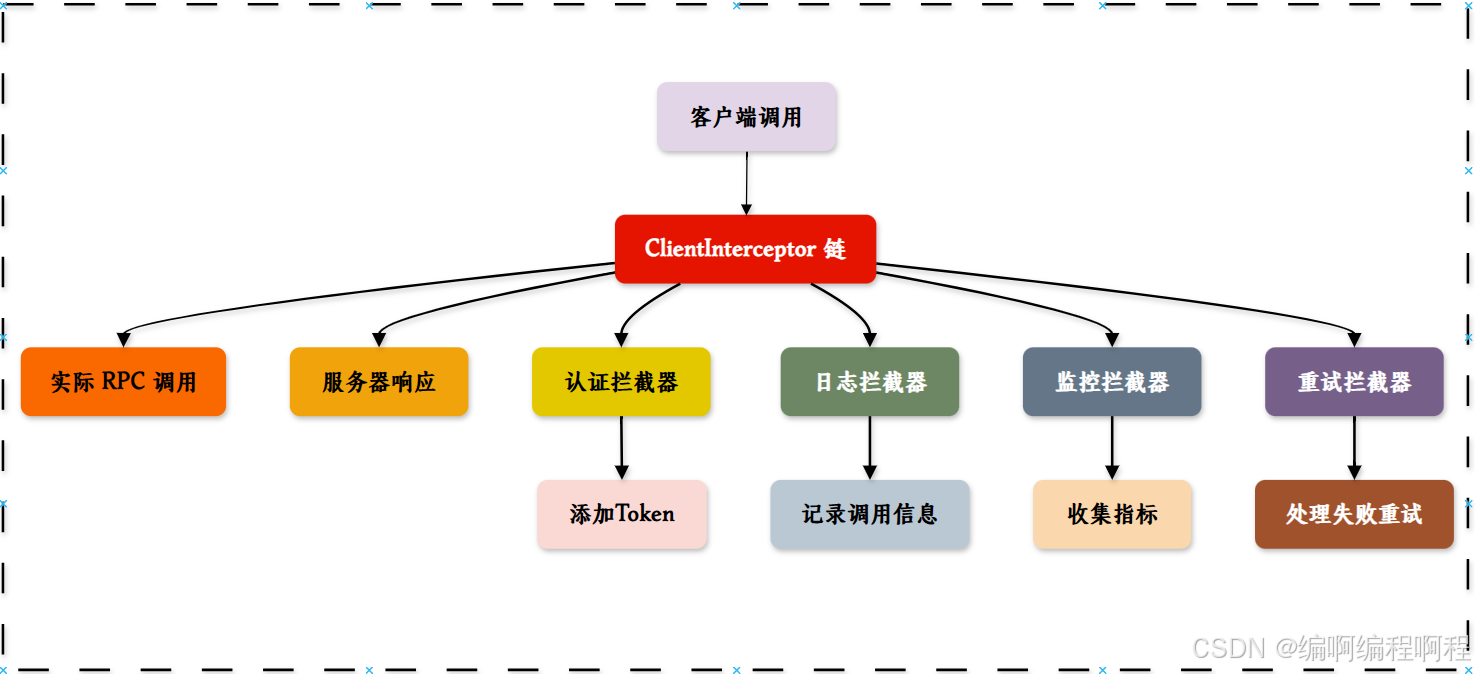gRPC从0到1系列【23】
文章目录
- gRPC拦截器
- 7.4 ClientInterceptor
- 7.4.1 什么是ClientInterceptor?
- 7.4.2 ClientInterceptor工作流程
- 7.4.3 常见应用场景
- 7.4.4 实战示例
- 7.4.5 重试、超时
gRPC拦截器
7.4 ClientInterceptor
gRPC 中的 ClientInterceptor(客户端拦截器)是一种强大的机制,允许开发者在客户端发起 gRPC 调用的前后插入自定义逻辑。这些逻辑可以用于日志记录、认证、监控、重试、超时控制、请求/响应修改等多种用途。
7.4.1 什么是ClientInterceptor?
ClientInterceptor 是 gRPC 客户端的一个扩展点,它可以在每次 RPC 调用执行前或执行后拦截请求和响应。它类似于 Web 开发中的“中间件”(middleware)。
在 gRPC 的 Java 实现中,ClientInterceptor 是一个接口:
public interface ClientInterceptor {<ReqT, RespT> ClientCall<ReqT, RespT> interceptCall(MethodDescriptor<ReqT, RespT> method,CallOptions callOptions,Channel next);
}
- method:描述被调用的方法(包括方法名、请求/响应类型等)。
- callOptions:调用选项(如 deadline、权威、压缩等)。
- next:下一个 Channel(可以是另一个拦截器或最终的底层通道)。
- 返回一个 ClientCall 对象,代表这次调用的封装。
相关核心类:
// 客户端调用接口
public abstract static class ClientCall<ReqT, RespT> {public abstract void start(Listener<RespT> responseListener, Metadata headers);public abstract void sendMessage(ReqT message);public abstract void halfClose();public abstract void cancel(String message, Throwable cause);public abstract void request(int numMessages);
}// 响应监听器
public abstract static class Listener<T> {public void onHeaders(Metadata headers) {}public void onMessage(T message) {}public void onClose(Status status, Metadata trailers) {}public void onReady() {}
}
7.4.2 ClientInterceptor工作流程
当你将一个或多个 ClientInterceptor 应用于 gRPC 客户端时,它们会按照注册顺序形成一个调用链。
MyServiceGrpc.MyServiceBlockingStub stub = MyServiceGrpc.newBlockingStub(channel).withInterceptors(interceptor1, interceptor2);
调用链顺序为:
stub → interceptor1 → interceptor2 → 实际网络调用
每个拦截器可以选择:
- 修改请求/响应;
- 添加 metadata(如认证 token);
- 记录日志;
- 处理异常;
- 控制调用流程(如提前终止、重试等)。
7.4.3 常见应用场景

7.4.4 实战示例
✅ 1. 添加认证信息
package cn.tcmeta.grpc.interceptor;import io.grpc.*;public class AuthInterceptor implements ClientInterceptor {private final String token;public AuthInterceptor(String token) {this.token = token;}@Overridepublic <ReqT, RespT> ClientCall<ReqT, RespT> interceptCall(MethodDescriptor<ReqT, RespT> method,CallOptions callOptions,Channel next) {ClientCall<ReqT, RespT> call = next.newCall(method, callOptions);return new ForwardingClientCall.SimpleForwardingClientCall<>(call) {@Overridepublic void start(Listener<RespT> responseListener, Metadata headers) {headers.put(Metadata.Key.of("authorization", Metadata.ASCII_STRING_MARSHALLER), "Bearer " + token);super.start(responseListener, headers);}};}
}
✅ 2. 日志记录
package cn.tcmeta.grpc.interceptor;import io.grpc.*;public class LoggingInterceptor implements ClientInterceptor {@Overridepublic <ReqT, RespT> ClientCall<ReqT, RespT> interceptCall(MethodDescriptor<ReqT, RespT> method,CallOptions callOptions,Channel next) {System.out.println("Calling method: " + method.getFullMethodName());ClientCall<ReqT, RespT> call = next.newCall(method, callOptions);return new ForwardingClientCall.SimpleForwardingClientCall<>(call) {@Overridepublic void sendMessage(ReqT message) {System.out.println("Sending request: " + message);super.sendMessage(message);}};}
}
7.4.5 重试、超时
可以通过包装 ClientCall.Listener 来监听失败,并在特定条件下重试.
虽然 CallOptions 支持 deadline,但拦截器可以动态设置:
CallOptions newOptions = callOptions.withDeadlineAfter(5, TimeUnit.SECONDS);
ClientCall<ReqT, RespT> call = next.newCall(method, newOptions);
